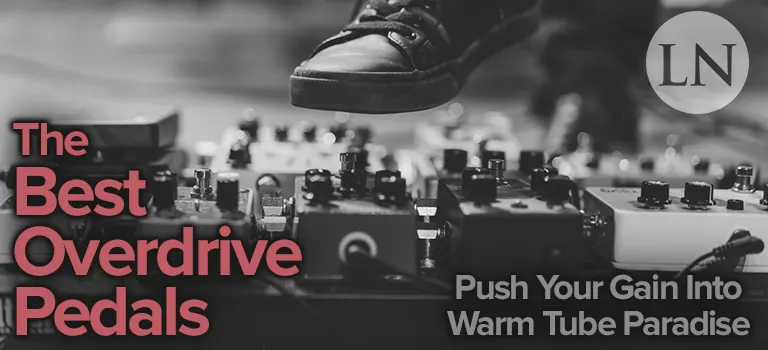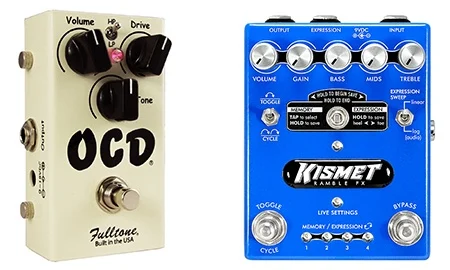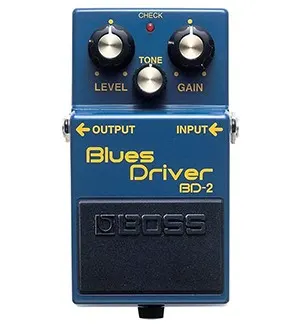The best overdrive pedal can turn your dry, boring tone into a warm, distorted timbre full of the subtle harmonics you get from pushing the gain on a tube. It’s the difference between a clean, handsome tone that nobody cares about and a relatable one with enough bite and character to keep the crowd’s ears listening and excitable…

The following review may contain affiliate links which may earn us a small commission when you click on them, at no extra cost for you. As an Amazon Associate we earn from qualifying purchases.
Guitar players have been praising and taking advantage of the subtle sounds of the overdrive effect for half a century now.
Although overdriving your amplifier was considered a mistake before, by the early 1960’s rock bands were purposefully creating this effect with their amps as engineers scrambled to create ways to achieve this without altering your overall volume levels.
Eventually the overdrive pedal hit the market and the game was changed forever.
We’re all used to hearing the growling, harsh sound of a hard-clipped square wave distortion in heavy metal, but most of us find the more more musical, soft clipping of overdrive distortion a much more pleasant experience.
This is often because it adds coloration and warmth to the signal thanks to the actual tube or tube-emulation. That should tip you off that you can find analog and digital versions of the circuits used in these pedals. Both have their strengths, albeit somewhat romanticized, over the other.
Let’s take a moment to discuss what features you should prefer in one of these pedals and how to properly use them, then we’ll take a look at our top picks among the modern generation of these tone-altering beasts.
Need more information in order to better understand your needs in terms of overdrive pedals? We have got you covered! Visit our FAQs Section
included in this guide:
| Ibanez TS9 Tube Screamer | Best Bang for the Buck | Buy on Amazon |
| Electro-Harmonix Soul Food | Best Alternative to Klon Centaur | Buy on Amazon |
| Fulltone OCD V2 | Best of the Best | Buy on Amazon |
| Boss SD-1 Super Overdrive | Best Budget Pick | Buy on Amazon |
| TC Electronic MojoMojo | Best for Fully Analog Distortions | Buy on Amazon |
| Boss BD-2 Blues Driver | Best Pedal for Blues | Buy on Amazon |
Ibanez TS9 Tube Screamer
Let’s start off with a classic, the Ibanez TS9 Tube Screamer. There’s hardly a more iconic pedal. It’s been on the scene since the 1970’s continuing to progress from model to model with varying amounts of extra features. The TS9 is a reissue of a 1980’s rendition that many guitar magazines have even declared as the best pedal of all time.
Some critics will say there aren’t enough options, but if you click through to Amazon you’ll see there is TS9B model that adds an EQ stage and TS9DX model that foregoes the EQ for a Mode knob offering the classic TS9 setting as well as Hot and Turbo modes. You can even pick it up in a mini / nano size if you prefer.
What is so appealing about the classic model is the simplicity and vintage tone you get. It’s not an overly driven high-gain pedal with no response, but quite the opposite. You’ll have plenty of room to influence the overdrive through your own dynamics.
Dig harder and you’ll get more character. Pick lighter and let the effect fall back a bit. In this way you can create a lively soundscape that accentuates your skill level. Or you can throw all of that out the window and push the drive knob to 11.
The TS9 Tube Screamer is a great addition to your distortion collection and can act as a very “hard to screw up” beginner’s choice. At the price, it’s hard to avoid not getting one of the best options out there just to play with, if not become your official overdrive pedal.
Specs:
- General: Classic tone, drive, and level controls
- Required Current: 8mA@9V
- Power Supply: One 9 volt battery (006P) or external AC adapter (Use only DC 9V (Center-negative))
Pros:
- Top-quality audio output
- Great price/quality ratio
- Good for beginners
Cons:
- Not versatile enough for other genres
- Lacks savable presets
ELECTRO-HARMONIX SOUL FOOD
It’s no surprise to see the Electro-Harmonix Soul Food make the list. It’s considered the best of the boutique Klon Centaur clones at a much cheaper price, making it a no-brainer for anyone hunting around in that particular sub-class. But it’s generalizable as one of the best, if not the best overdrive pedal by some, too.
Where it excels is providing a very sensitive overdrive that responds to your own playing dynamics while maintaining a sense of transparency so your own tone shines through with a pleasing, albeit slight, low-mid bump for added warmth.
Many like this pedal for the higher output available that can provide a clean boost or a smooth, crunchy overdrive with plenty of bass added. This is possible thanks to the boosted power rails that allows for tons of headroom and definition. The warmth and bass are what add the “soul” to the Soul Food pedal, all without being muddy.
You can then control the high-end with the Treble knob which is a high roll-off. You can back off of the Drive to have less bass and treat it more as a clean boost if preferred. The options are endless here on this vintage, retro sounding pedal. Many consider this essentially as a giveaway at the price compared to the original Klon Centaur. Check it out if you’re aware of that sound and want access to it.
Specs:
- Circuit: Analog
- Power Supply: 9.6VDC-200mA power adapter
- Current Draw: 22mA
Pros:
- Sensitive, responsive overdrive
- Great quality
Cons:
- More advanced producers may find this too “entry-level”
FULLTONE OCD V2
Even though there are close contenders, the Fulltone OCD v2 is the current king of overdrive. There’s not even any debate around it. Everyone agrees that not only does the OCD provide the most desirable tone, but it comes at a price tag you won’t even flinch at for the benefits. And now the V2 version features a buffered output, a higher impedance input, and more.
Part of the appeal are the two modes (notice the HP/LP switch above the red LED) which are High Peak and Low Peak. The LP setting provides a less aggressive effect that allows your own tone to shine through, while the HP setting is far more overt for when you really want to drive the pedal. Fulltone describes LP as “Fender-ish” and HP as “British.”
Of course those two settings can be tweaked in nearly endless ways with the volume, drive, and tone pedals. And when you want no effect, you can disengage and place it into true bypass.
From Classic Rock to Blues, from bright tones down to a booming bass low-end, you won’t find an application where you can’t create a setting where the OCD won’t improve your sound. Many players remark that they never turn theirs off, only move through varying amounts of the distortion depending on the song or solo. This is one of the rare places where most guitarists agree that there is a clear category winner.
Specs:
- General: Buffer output, Class-A wired JFET input, Internally selectable “True-Bypass” or “Enhanced BypassTM”
- Power Supply: 9-volt battery or standard DC adapte
- Current Draw: 8mA
Pros:
- Wide range of voicing on the tone control
- Simple, no-fuss operations
Cons:
- 18V needed for best sound
BOSS SD-1 SUPER OVERDRIVE
Everyone has seen Boss pedals. They all look the same with different colors and knob labels. But don’t be fooled by a “plain Jane” appearance. The Boss SD-1 Super Overdrive earns it’s spot as the best cheap option out there and competes very well with the more expensive choices. This bad boy aims more at aggression and color than playing it safe and transparent.
Designed over 20 years ago, the SD-1 got it right the first time and still remains a go-to choice for many players. As the “Super” nomenclature would have you suspect, you can push this balanced overdrive into a far more chaotic sound for some extra character that never leaves the realm of normal expectation. What I mean is that you can venture a little closer to the realm of “distortion” than most overdrive pedals offer, but it’s still closer to the overdrive side of things.
Use it as a clean channel or as an overdrive, either way what you’re getting here is a standard sound with the ability to drive harder with a reliable build that you can trust to last you forever. Boss’ construction quality is top-notch. The asymmetrical clipping keeps things sounding very natural, like a overdriven tube amp, even through its digital circuitry. It’s an industry standard for a reason.
Specs:
- General: Compact design, analog technology, buffered bypass
- Power Supply: 9-volt battery
- Current Draw: 4mA
Pros:
- Loved by generations of players
- Legendary genre-defining sound and feel
Cons:
- Only has basic features
TC ELECTRONIC MOJOMOJO
Perhaps the most handsome on the list is the TC Electronic MojoMojo. Unlike others on this list that digitally produce the distortion, the MojoMojo is fully analog. In my mind that’s not better or worse, though many seek out analog options since older can often be better these days.
Regardless of the construction, this beast stacks up as one of the best and offers a bit more features, including a two-band equalizer, true bypass, the option to be powered through a battery, and a voice switch.
The voice switch essentially a mid-boost letting you accentuate or suck some life out of the warmth. You can quickly change the tonal quality of the output in this way without having to tinker with the EQ knobs, which is great especially if you’re switching guitars often on stage, such as moving from a single-coil pickup to a humbucker. Although it’s considered a neutral overdrive, there’s no end to the sounds you can create with the knobs. This is a formidable stompbox that pleases even the most strict critics.
The bass knob offers far more versatility than you would expect. Turn it down to get that harsh, thin-sounding crunch or turn it up for a thick, warm low-end that provides the mojo its name implies. If you’re seeking versatility for your signal chain and you don’t already have a sizable pedal collection, this will fill the EQ gap well while adding a very pleasing overdrive to your signal path.
Specs:
- General: Compact design, true bypass for zero loss of tone, analog technology
- Power Supply: 9-volt battery
- Current Draw: 16mA
Pros:
- Designed for stacking
- High quality built
- Nice, open distortion with low compression perfect at higher gain settings
Cons:
- Can sound slightly compressed and mushy if not paired with a great (& properly set) EQ
BOSS BD-2 BLUES DRIVER
Like the others here, the Boss BD-2 Blues Driver delivers a warm and crunchy overdrive but adds in a nice creamy flavor for the blues players. It shouldn’t be discounted for any other rock genre, though. Versatility is the name of the game here. Plus Boss builds their pedals like tanks.
Countless Blues, Pop, Rock, and Alternative professional guitarists still put their faith in this pedal (like John Mayer and Billie Joe Armstrong, for instance) during live performances. Like most, the Tone takes you from bright to dark, while the Gain can take you from a cleaner grit all the way to a very warm and crunchy sound. Most consider this a far more predictable pedal that consistently provides the overdrive effect that you’ve come to expect. It’s excels at what you expect versus carving its own niche sound.
The Blues Driver is a favorite among Stratocaster players who feel the boosted treble is balanced by the warmth and bite of the pedal. Compared to the Super Overdrive by Boss above, this one is that plus a dash of gain and edge, taking it to the next level when pushed harder.
Specs:
- General: Classic “blues” guitar tones with tube amp simulation with warm distortion and overdrive
- Power Supply: AC adaptor or 9V battery operation
- Current Draw: 20mA
Pros:
- Great tone and adaptable gain structure
- High quality, crunchy sound
Cons:
- Depending on the settings, the original circuit can sound thin.
FAQs
The subtle, yet gritty, overdrive effect is found in countless professional recordings and live musical events in nearly every genre. This ubiquitous desire to apply it has led to the top manufacturers not only producing the best units available but competing to drive the prices as low as possible.
This is great for us, the consumer, which you’ll have noticed as you browsed our selection above of the best overdrive pedals on the market.
What is the Overdrive Effect?
Overdrive is a sub-type of the distortion effect, achieved by increasing the gain of an audio signal until it begins to break up and have a “fuzzy, growling, gritty” aspect to it. For overdrive specifically, the effect was originally created by pushing the gain through a vacuum tube amplifier too high. The name comes from this act of overdriving the tube.
Overdrive is seen as a subtler form of the common distortion effect. When tubes are provided with too much gain, the audio waveform is clipped off while sustain is added along with harmonic overtones. This results in a compressed sound that has a sense of warmth along with the gritty sound of the distortion.
Although some pedals and amplifiers with tubes are still used to achieve the overdrive effect, solid-state electronics and digital processors that emulate specific overdriven amplifiers are more common today.
What to Look for in the Best Overdrive Pedal?
Of course, you’ll want to try to hear examples of a pedal you’re interested in by watching videos, but that’s not always accurate. You’ll largely be safe these days by trusting specific models by manufacturers with great reputations, in terms of the quality of the build and of the tone. Most feature so many knobs and even equalization stages that you can define nearly any tone of overdrive you want.
Another thing to consider is whether you play lead or rhythm and your other gear. As lead guitarist you might want to accentuate higher frequencies while sitting back in the mix more as a rhythm guitarist. Some pedals may be known more for a specific frequency response, although you can alter any of this on the pedal usually or even by placing an EQ after it if needed.
Beyond these considerations, they all tend to feature the same three knobs that give you all the choices you need. Sometimes, they’re all so good in their class that it boils down to which one you like the look of best and the price range you’re shopping in. That’s how it is in the overdrive world.

How to Use an Overdrive Pedal
Overdrive, like all forms of distortion, is a very obvious effect. That means if you don’t use it right, your fan base is going to wonder why you’re sounding so amateur. You have to place it in the right order in your pedalboard, foremost, and then tweak the knobs correctly to get a professional sound. But how is this done?
Where to Place it in the Signal Chain
There is a very strict order all your types of guitar pedals should be placed in as defined by logic, nature, and the necessity of other pedals based on their needs and ability to ruin everything. It looks like this:
- Dynamics, Filters, & Pitch Shifters
- Boost & Distortion
- Modulation
- Time
Overdrive belongs in the second stage, called the Gain group. That’s because it depends on a high-gain signal to do its job. You’ll want to take care of all of your waveform shaping, filtering, and pitch shifting before boosting your volume and sending it to the overdrive pedal because once you do there’s no tweaking those aspects.
And you want to distort before you modulate or add reverb and delay. You want distortion to be a part of those effects and not applied to them or it’s going to sound absurd, muddy, unprofessional, and unnatural. It will, without a doubt, be noticed if you don’t do this right.
Understanding the Knob Settings
Overdrives haven’t gone the way of other effects where the pedal manufacturers are inventing crazy names for each knob and adding unneeded features. It’s still sane and you’ll generally only see three knobs to use. These are Gain, Level, and Tone.
Gain, which is sometimes called Drive, lets you define the volume at the input so you can choose how intense you want the distortion to be. Volume lets you choose your loudness at the output. Tone is a high shelf equalizer boost that you can sweep up and down the frequency spectrum to control your brightness.
Some pedals will include a switch for a high-pass or low-pass filter that changes the tone knob so you can go for a darker sound if you prefer instead of bright. And that’s it! Pretty simple once you know where to place it in the pedal chain.





